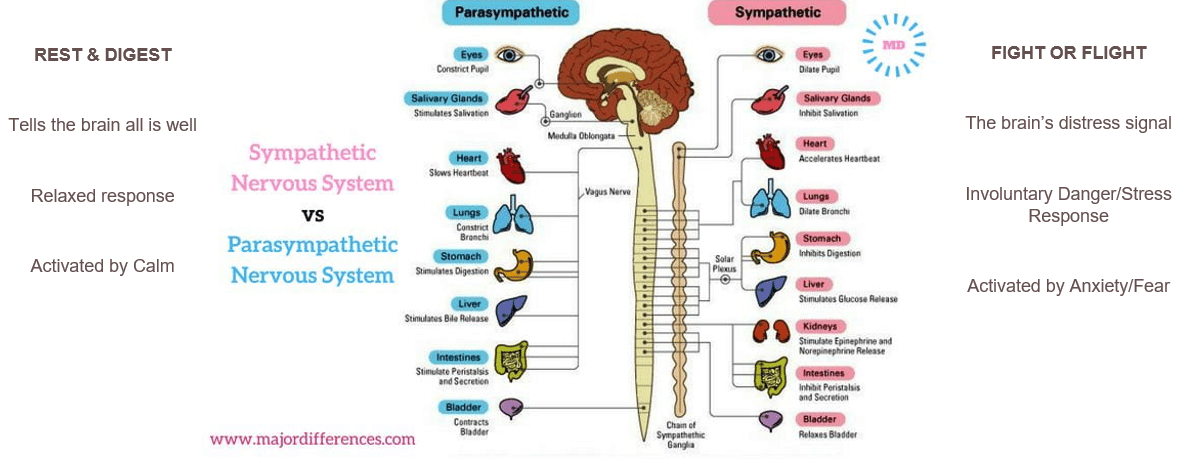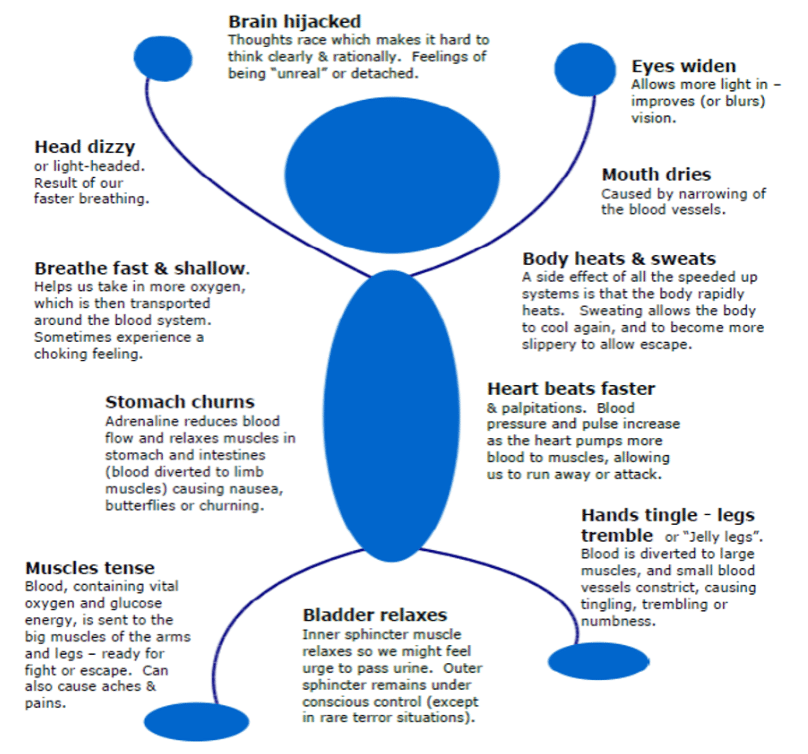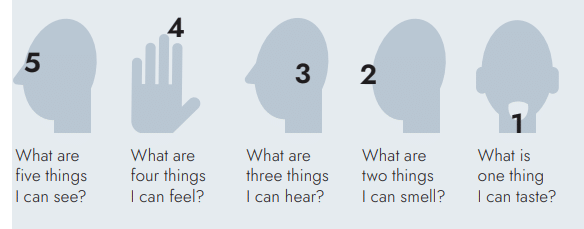Anxiety
What is anxiety?
Anxiety is a feeling of unease, worry or fear. This is a naturally occurring emotion that serves as an automatic response to danger, or threats. Anxiety is an essential emotion for protection, and it serves as the body’s “built-in alarm system”. Every person will experience anxiety many times throughout their life, just as they will experience all other human emotions.
However for some people, this feeling can become constant or overwhelming, or occur in situations that the individual would not normally feel anxious in. This is typically characterised as an anxiety disorder, something 1 in 10 people will see their GP for.
Long COVID and anxiety
Long-COVID and COVID-19 can be triggers for anxiety in some individuals. These psychological symptoms can result from a combination of the effects of the immune disturbance caused by the virus, the brain toxicity of the virus and psychological trauma associated with the virus and illness.
Dealing with the physical symptoms of Long Covid, particularly fatigue and breathlessness, and the associated inability to resume normal roles and routines can be very stressful, isolating and traumatic. When we don’t recover within an expected time frame, this can lead to frustration, confusion and fear which can then lead to anxiety and depression.
- Stay informed. Don’t obsessively check the news or social media and stay away if you feel overwhelmed. Stick to trustworthy sources only, such as the NHS and Your COVID Recovery.
- Follow guidelines on preventing the spread of the virus.
- Focus on the things within your control.
- Stay connected. Talk to someone, particularly if you are physically isolated.
- Re-frame negative thoughts. Don’t let COVID dominate your thoughts or conversations.
- Take care of yourself.
- Maintain a routine and structure your day.
- Make time for enjoyment, exercise and relaxation.
- Get outdoors, get a daily dose of sunlight!
How common are the psychological effects of Long COVID?
- 57% said that Long Covid had negatively affected their wellbeing (Office for National Statistics, 2021).
- 25% were likely to have some form of anxiety (Office for National Statistics, 2021).
- 30% reported experiencing moderate to severe depressive symptoms (Office for National Statistics, 2021).
- 11.5% experienced symptoms of PTSD (Sindhu et al, 2021).
- Psychological symptoms were more prevalent in those experiencing continued multiple physical symptoms (Sindhu et al, 2021).
- Stress from enduring a potential fatal disease
- Fear of illness / health anxieties
- Stigma of having the illness
- Traumatic memories of severe illness or time in hospital (PTSD)
- Social isolation
- Persisting symptoms and inability to resume normal life/employment
- Uncertainty about the future
- Reduced wellbeing and quality of life
- Exacerbation or relapse of previous anxiety or depression
- Psychological effects of pandemic (isolation, change in routine and lifestyle, health worries)
What causes anxiety?
Anxiety is an emotion that involves a specific set of hormones or “signals” such as adrenaline within the body. It is the body’s natural response to danger or fear. This can be caused by the following:
- Over-activity in the areas of the brain involved with emotions and behaviour.
- An imbalance of serotonin and noradrenaline which help to control and regulate mood.
- Disordered thinking.
- Life Stressors. This can include things like work, relationships and finances.
- Trauma, abuse, bereavement.
- Health Issues such as pain and chronic conditions.
- Upcoming events like tests and exams.
When the body is ‘stressed’ the brain sends out a distress signal. This activates:
- the sympathetic nervous system
- the flight / flight response (production of adrenaline and cortisol)
Adrenaline increases your heart rate, elevates your blood pressure and boosts energy supplies
Cortisol, the primary dress hormone, increases sugars (glucose) in the bloodstream, enhances your brain’s use of glucose and increases the availability of substances that repair tissues.
The Autonomic nervous system controls functions in the body like breathing, heart rate, digestion and many other things. It is a key player in the production and regulation of stress in the body.
Activation of the parasympathetic nervous system allows the body to relax and digest food. This happens when you are calm and do not feel threatened.
When the body is ‘stressed’ the brain sends out a distress signal which activates the sympathetic nervous system and leads to a fight or flight response (production of Adrenaline and Cortisol). This leads to an increase in heart rate, blood pressure and energy availability within your body.
The polyvagal theory suggests that trauma or PTSD can lead to exaggerated stress responses and chronic overactivity in the sympathetic nervous system.

When our environment feels safe and calm our body state is regulated efficiently (parasympathetic state).
When our mind detects danger or threat (real or perceived) this puts the body into ‘flight or flight’ mode (stress response).
When you experience trauma or PTSD, this can lead to a continued and exaggerated stress response (sympathetic state).
A fight or flight response is a natural bodily response to danger, fear or stress, like an automatic alarm system which prepares your body for action so it can respond quickly if necessary. Fears, phobias and irrational thinking can falsely trigger this response if they are perceived as a threat, which leads to physical symptoms.
- Energy (Adrenaline) is rushed from the adrenal glands into the bloodstream to signal to large muscle groups that they need to be ready to either flee or fight.
- Cortisol (Stress Hormone), is released into the bloodstream which increases blood sugar (glucose) concentration to enhance brain activity.
- This response causes rapid heart rate, increased blood pressure, dizziness, shallow breathing, sweating, hypervigilance. They also curb bodily functions that are non-essential or harmful in a fight or flight situation such as digestion.
- Helpful in truly threatening situations but a hindrance if activated falsely
- Can take 20-60 minutes for body to return to normal

When we anticipate stress we tend to hold our breath
Extra oxygen is sought by the body in order to supply muscles with maximum energy in order to ‘fight’ which causes over-breathing (or hyperventilation).

Typical symptoms of anxiety
The symptoms of anxiety can be broadly broken up into three categories, physical, psychological and behavioural.
Anxiety brings physical sensations with it that can feel incredibly uncomfortable, and even make you feel more anxious. It is important to know that these feelings cannot and will not cause any harm, no matter how quickly they come on or how serious they feel.
- Butterflies in stomach, churning, feeling sick
- Fast, thumping heart
- Palpitations
- Rapid breathing (hyperventilation)
- Ringing in the ears
- Dry mouth and tight throat
- Weakness in legs/feels like jelly
- Headache/dizziness/blurred vision
- Tense muscles
- Pins & needles
- Trembling/Shaking
It can be common for feelings of panic to occur from time to time. This can affect everybody slightly differently, but usually includes feelings that something bad is going to happen. Panic attacks are not dangerous and are not a sign of serious mental or physical illness. It is just a fight or flight response occurring in a way that feels uncomfortable.
- Fear
- Panic or Terror
- Distress
- Uncertainty
- Embarrassment
- Irritability
- Anger
- Excitement
- Distress
- Loss of control
When experiencing panic or anxiety, people can behave in ways that they would not normally. These behaviours can include:
- Agitation or restlessness
- Pacing
- Verbal physical aggression
- Safety behaviours – avoiding people, places or situations
- Staying in or needing someone with you in certain situations
- Paranoia / jumping to negative conclusions
- Fear of losing control
- Disturbed sleep / insomnia
- Noise intolerance
- Difficulty concentrating
- Using unhelpful coping strategies – smoking, drinking drugs, biting nails
The Anxiety Cycle

Panic
- An extreme form of fear… in an ordinary situation
- The longer you are anxious, the more hypervigilant you become
- The body’s normal fear reaction becomes oversensitive and is then triggered in ‘normal situations
- Anytime you feel slightly worried this will trigger the body’s normal fear reaction
REMEMBER – panic attacks are not dangerous
RECOGNISE – your symptoms
UNDERSTAND – what causes it and what keeps it going.
ACCEPT – the feelings are not harmful and do not indicate anything is seriously wrong
LEARN – techniques and coping strategies
Once you understand what is going on, half the battle is won!
- Panic is a normal reaction to fear that is exaggerated. It is not dangerous.
- Symptoms are not harmful. Nothing bad will happen. The feelings will pass.
- Acknowledge what is happening to your body and try to relax and stay in the present moment.
- Only think about now. Thinking about what might or could happen is unhelpful.
- Accept the feelings.
- Monitor the level of anxiety (0-10) and watch it come down.
- Stay in the situation. Avoid running away, avoiding it or escaping as this will make it more difficult in the future.
- Take deep breathes. Say or visualise the word calm.
- Relax tense muscles. Feel yourself relaxing. Drop your shoulders.
- Concentration what you were doing before.
Breaking the cycle of anxiety
Identify your triggers
People suffering from anxiety can often find that their anxiety is triggered by certains things. These could be anything from a particular social situation, a thought, certain times of day. Identifying these can be helpful. Try to look for patterns:
- When do you usually get anxious?
- What are you thinking that makes you feel anxious?
- What makes you anxious – places/people/certain times of day?
- What are your triggers – sounds/smells/reminders?
- Which factors keep your anxiety going?
- What are your safety behaviours?
Trying to avoid triggers will likely have an impact on your quality of life, narrowing your comfort zone, so it can be helpful to make a plan to gradually do the things you normally avoid and to reduce your safety behaviours.
Cognitive distortions
Just because you think a certain thing doesn’t mean it is true. Anxiety is often caused by cognitive distortions. These are habitual, disordered thoughts that come in the form of unhelpful thoughts and beliefs, and negative interpretations.
Sometimes called all-or-nothing, or black and white thinking, this distortion occurs when people habitually think in extremes. When you’re convinced that you’re either destined for success or doomed to failure, that the people in your life are either angelic or evil, you’re probably engaging in polarized thinking.
This kind of distortion is unrealistic and often unhelpful because most of the time reality exists somewhere between the two extremes.
When people overgeneralize, they reach a conclusion about one event and then incorrectly apply that conclusion across the board.
For example, you make a low score on one math test and conclude that you’re hopeless at math in general. You have a negative experience in one relationship and develop a belief that you just aren’t good at relationships at all.
Overgeneralization has been associated with post-traumatic stress disorder and other anxiety disorders.
This distorted type of thinking leads people to dread or assume the worst when faced with the unknown. When people catastrophize, ordinary worries can quickly escalate. For instance, an expected check doesn’t arrive in the mail. A person who catastrophizes may begin to fear it will never arrive, and that as a consequence it won’t be possible to pay rent and the whole family will be evicted.
It’s easy to dismiss catastrophizing as a hysterical over-reaction, but people who have developed this cognitive distortion may have experienced repeated adverse events — like chronic pain or childhood trauma — so often that they fear the worst in many situations.
One of the most common errors in thinking is taking things personally when they’re not connected to or caused by you at all. You may be engaging in personalization when you blame yourself for circumstances that aren’t your fault, or are beyond your control.
Another example is when you incorrectly assume that you’ve been intentionally excluded or targeted. Personalization has been associated with heightened anxiety and depression.
When people assume they know what others are thinking, they’re resorting to mind reading.
It can be hard to distinguish between mind reading and empathy — the ability to perceive and understand what others may be feeling.
To tell the difference between the two, it might be helpful to consider all the evidence, not just the evidence that confirms your suspicions or beliefs.At least one study has found that mind reading is more common among children than among adolescents or adults and is associated with anxiety.
Another distorted thought pattern is the tendency to ignore positives and focus exclusively on negatives.
Interpreting circumstances using a negative mental filter is not only inaccurate, it can worsen anxiety and depression symptoms.
Researchers trusted source have found that having a negative perspective of yourself and your future can cause feelings of hopelessness. These thoughts may become extreme enough to trigger suicidal thoughts.
Like mental filters, discounting the positive involves a negative bias in thinking.
People who tend to discount the positive don’t ignore or overlook something positive. Instead, they explain it away as a fluke or sheer luck.
Instead of acknowledging that a good outcome is the result of skill, smart choices, or determination, they assume that it must be an accident or some type of anomaly.
When people believe they have no control over their circumstances, it can reduce motivation and cultivate a sense of “learned helplessness.”
When people find themselves thinking in terms of what “should” and “ought” to be said or done, it’s possible that a cognitive distortion is at work.
It’s rarely helpful to chastise yourself with what you “should” be able to do in a given situation. “Should” and “ought” statements are often used by the thinker to take on a negative view of their life.
These types of thoughts are often rooted in internalized family or cultural expectations which might not be appropriate for an individual.
Such thoughts can diminish your self-esteem and raise anxiety levels.
Emotional reasoning is the false belief that your emotions are the truth — that the way you feel about a situation is a reliable indicator of reality.
While it’s important to listen to, validate, and express emotion, it’s equally important to judge reality based on rational evidence.
Researchers have found from trusted sources that emotional reasoning is a common cognitive distortion. It’s a pattern of thinking that’s used by people with and without anxiety or depression.
Labelling is a cognitive distortion in which people reduce themselves or other people to a single — usually negative — characteristic or descriptor, like “drunk” or “failure.”
When people label, they define themselves and others based on a single event or behaviour.
Labelling can cause people to berate themselves. It can also cause the thinker to misunderstand or underestimate others.
This misperception can cause real problems between people. No one wants to be labelled.
Don’t believe everything you think!
- Is the threat real or perceived or is it fact or opinion?
- Are the physical feelings anxiety-related? (fight or flight/adrenaline response)
- How likely is what you are thinking going to happen?
- Are you exaggerating or misreading the ‘threat’? Are you thinking rationally?
- What would a trusted friend say to me right now?
- What advice would I give to a friend?
- Are your feelings making the situation worse than it is?
- Is there a more helpful way of looking at the situation?
You CAN cope with these feelings. You have got through this before. IT WILL PASS.
How can you change these distortions?
The good news is that cognitive distortions can be corrected over time.
Here are some steps you can take if you want to change thought patterns that may not be helpful:
When you realize a thought is causing anxiety or dampening your mood, a good first step is to figure out what kind of distorted thinking is taking place.
To better understand how your thoughts affect your emotions and behavior, you may want to consider reading “Feeling Good: The New Mood Therapy” by clinical psychologist Dr. David Burns. This book is considered by many to be the definitive work on this subject.
Look for shades of gray, alternative explanations, objective evidence, and positive interpretations to expand your thinking.
You might find it helpful to write down your original thought, followed by three or four alternative interpretations.
People usually repeat behaviors that deliver some benefit.
You might find it helpful to analyze how your thought patterns have helped you cope in the past. Do they give you a sense of control in situations where you feel powerless? Do they allow you to avoid taking responsibility or taking necessary risks?
You can also ask yourself what engaging in cognitive distortion costs you. Weighing the pros and cons of your thought patterns could motivate you to change them.
Break the cycle
- Don’t avoid situations
- Re-frame the situation
- Take things slowly and gradually
- Shift to an external, rather than internal, focus
- Think of the longer term, bigger picture
- What has happened before? What can you change?
- What helps?
STOPP is CBT in a nutshell.
Learn this ONE KEY SKILL and you can start to take control of our emotions and your life.
- Practice the first two steps often for a few days – many times every day at any time.
- Read through the steps often.
- Carry written reminders with you.
- Practise STOPP by running through all the steps several times a day, every day…when you don’t need it.
- Start to use it for little upsets. Gradually, you will find that you can use it for more distressing situations. Like any new habit or skill, it will become automatic over time.
CBT is a technique that has been clinically proven to help some people overcome their anxiety. The acronym STOPP represents a simple CBT technique that can be learned in just a few minutes and practiced regularly to improve your anxiety. More details on using STOPP can be found here.
The steps explained:
Say it to yourself, in your head, as soon as you notice your mind and/or your body is reacting to a trigger.
Stop! helps to put in the space between the stimulus (the trigger, whatever we are reacting to) and our response.
The earlier you use STOPP, the easier and more effective it will be.
Breathing a little deeper and slower will calm down and reduce the physical reaction of emotion/adrenaline.
In through the nose, out through our mouth – the brain’s reset mechanism.
Focusing on our breathing means we are not so focused on the thoughts and feelings of the distress, so that our minds can start to clear and we can think more logically and rationally.
We can notice the thoughts going through our mind, we can notice what we feel in our body, and we can notice the urge to react in an impulsive way. We can notice the vicious cycle of anxiety, sadness or anger (etc).
Noticing helps us to detach from those thoughts and feelings and therefore reduce their power and control.
The thought-challenging part of CBT. Thinking differently.
Don’t believe everything you think! Thoughts are thoughts, not statements of fact.
When we step back emotionally from a situation, and start to see the bigger picture, it reduces those distressing beliefs. We can do this by asking ourselves questions.
This is the behavioural change of CBT. Doing things differently.
Rather than reacting impulsively with unhelpful consequences, we can CHOOSE our more helpful and positive response.
Shift our focus of attention.
Treatments for anxiety
Though anxiety can have an affect on your daily living, there are different treatments available to help. Some treatments are undertaken by professionals, other treatments can be done by you.
Psychological therapies such as Cognitive Behavioural Therapy (CBT) – you can refer yourself for psychological therapies by checking your local therapy services, there is no need to wait for a GP to do the referral for you. Other therapies include:
- Counselling / Talking Therapies
- Applied Relaxation Therapy
- E-therapy
Take slow gentle breaths and ask yourself:

Think of the answers slowly to yourself, one sense at a time, and spend at least 10 seconds focusing on each one.
It’s important to remember that your symptoms are a normal part of recovery following COVID-19. Worrying and thinking about your symptoms can often make them worse. For example, if you focus on headaches, you’re likely to get more headaches. Managing stress, anxiety, depression and sleep problems
Also, it’s important to know that symptoms are often linked: an increase in one symptom leads to an increase in another symptom. If you’re fatigued, your concentration will be affected, which in turn will affect your memory, which can then increase your anxiety and, consequently, your fatigue. As you can see, this can become a cycle. An improvement in one area therefore should lead to an improvement in another.
Medication such as antidepressants which work by balancing the chemicals in your brain which affects emotions and mood. Antidepressants can also help with sleep and increase your appetite and concentration. These medications can be prescribed by GP’s:
- SSRIs – Selective Serotonin Reuptake Inhibitors (Sertraline/Citalopram/Paroxetine)
- SNRIs – Serotonin and Noradrenaline Reuptake Inhibitors (Venlafaxine/Duloxetine)
- Anticonvulsants – Beneficial in treating anxiety (Pregabalin)
- Benzodiazepines – Sedatives for short-term use (Diazepam)
Self-help techniques such as having a healthy diet, meditation, exercising (even if it is just walking), reducing or cutting out alcohol. Even identifying your own triggers and what you already do in your life that helps is useful.
Some of the things that can help with anxiety include:
- Self-help books/books on prescription
- Self-help courses
- Self-help worksheets
- Peer support groups
There are also many apps in the NHS Apps library that are designed to help with anxiety:
- Catch It – learn to manage negative thoughts and look at problems differently (free)
- Chill Panda – use breathing techniques to help you relax more (free)
- Cove – Create music to reflect emotions like joy, sadness and anger to express how you feel (free)
- distrACT – info and advice about self-harm and suicidal thoughts
- eQuoo emotional fitness game – adventures games designed by psychologists to help you increase emotional fitness
- Feeling Good: positive mindset – uses audio tracks to help relax your body and build your confidence
- My Possible Self: The Mental Health App – learn how to manage fear, anxiety and stress and tackle unhelpful thinking
- Stress and Anxiety Companion – breathing exercises, relaxing music and games to calm you mind and change negative thoughts
- Thrive – Use games to track your mood and teach yourself methods to take control of stress and anxiety
- WorryTree – Notice record and manage worries using CBT techniques
- Calm
- Headspace
Some online courses and websites that you can engage in include:
Get enough quality sleep:
- have a regular routine of sleeping and waking time, using alarms if needed to
remind you; - you or your family/carers can try to ensure that your environment is free from
things that might disturb you, such as too much light or noise; - try to stop using electronic devices like phones and tablets an hour before
bedtime; - it would also help to minimize your intake of nicotine (such as from smoking),
caffeine and alcohol; and - try relaxation techniques to get to sleep.
Alternative relaxation techniques: examples of relaxation techniques include meditation, mindfulness, guided imagery or visualization, baths, aromatherapy, Tai Chi, yoga and music.
Staying socially connected is important for your mental well-being. Talking with others can help to reduce your stress and support you.
Healthy eating and gradually resuming your daily activities or hobbies to the best of your ability will improve your mood.
Helplines and support groups
Tel: 116 123
Email: jo@samaritans.org
Website: www.samaritans.org.uk
Samaritans offer emotional support 24 hours a day.
Tel: 0300 003 7026
Website: www.selfhelpservices.org.uk/sanctuary
The Sanctuary provides support for adults in crisis and those experiencing anxiety, panic attacks, depression or suicidal thoughts. (8am – 6pm)
Tel: 0800 470 8090
Webpage: https://www.thesilverline.org.uk/
The Silver Line is a helpline and friendship service for people aged 55 and over. All helpline calls are free. The Silver Line Helpline is free to callers. All costs of calls are covered by The Silver Line. We rely entirely on donations from organisations and people who care about the welfare and safety of older people. (24 Hours)
Tel: 0800 068 4141
Text: 07786 209697
Email: pat@papyrus-uk.org
Webpages: www.papyrus-uk.org
This is a confidential suicide prevention helpline service for young people thinking about suicide or for anyone concerned about a young person.
10am – 10pm weekdays, 2-10pm weekends and 2-5pm Bank Holidays
Tel: 0800 58 58 58
Webpage: www.thecalmzone.net/
Campaign against Living Miserably – This helpline is for people in the UK who are down or have hit a wall for any reason, who need to talk or find information and support. (Daily 5pm – Midnight)
Tel: 0300 123 3393
Webpage: www.mind.org.uk/
If you need non-urgent information about mental health support and services that may be available to you. (Monday – Friday 9am – 6pm)
Tel: 0300 123 3393
Webpage: www.rethink.org/
If you need non-urgent information about mental health support and services that may be available to you. (Monday – Friday 9am – 6pm)
Tel: 0800 678 1602
Webpage: www.ageuk.org.uk/information-advice/health-wellbeing/mind-body/mental-wellbeing/
If you prefer to talk to someone face to face, your local Age UK can suggest reliable sources of information and advice. They also have their own information and advice service which can help you with issues such as social care, welfare benefits and housing. (Everyday 8am – 7pm)
Resources
Disclaimer: This video has been created for a Cambridge and Peterborough audience so please ignore any references to the local service, instead use the content appropriately for your own care.
Thank you to the contributors for this section



